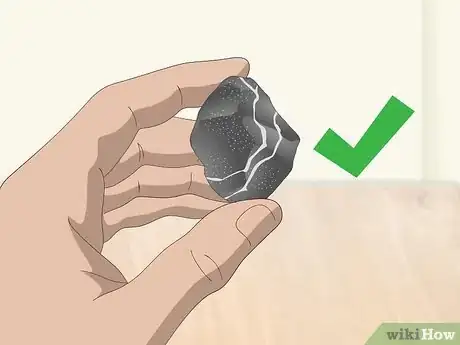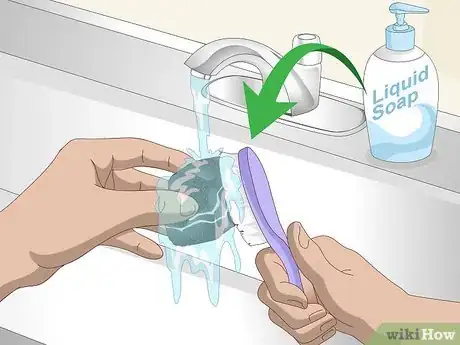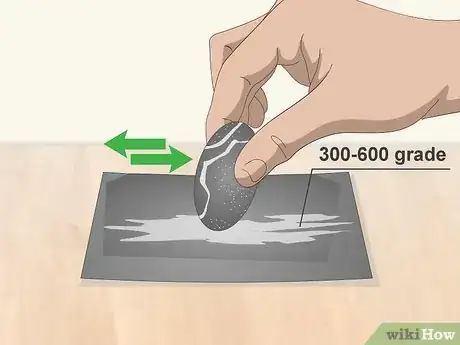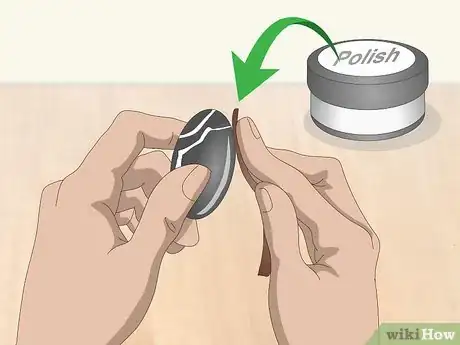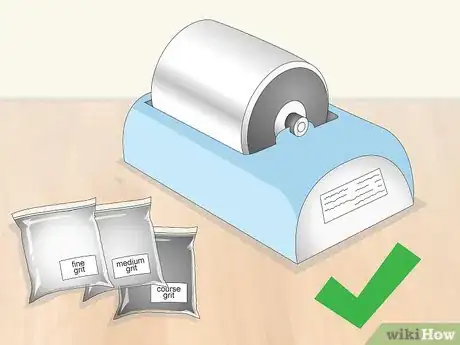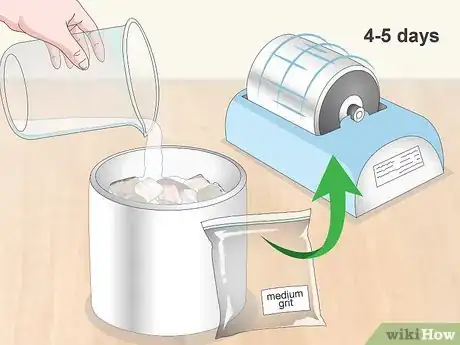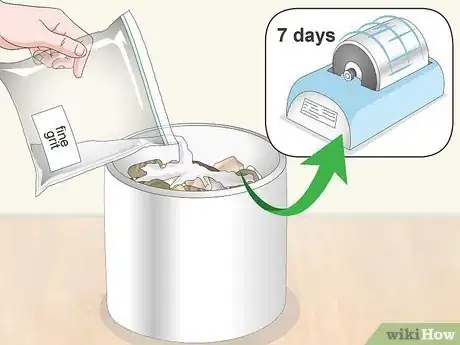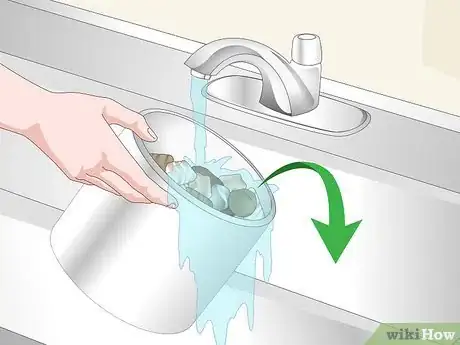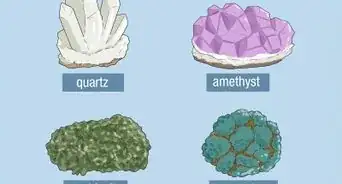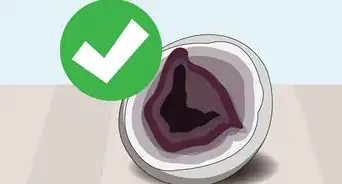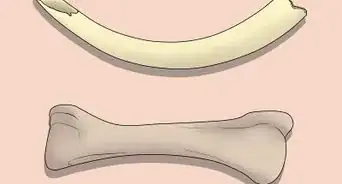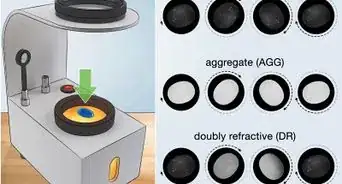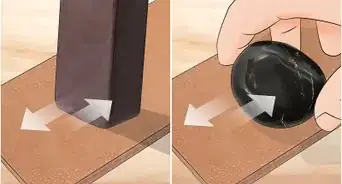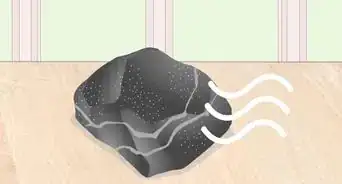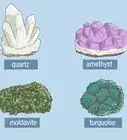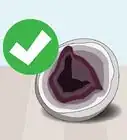This article was co-authored by Kennon Young. Kennon Young is a Master Gemologist Appraiser and the Owner of Vermont Gemological Laboratory in Burlington, Vermont. With over 20 years of experience in the industry, Kennon and his team specialize in handmade engagement rings, wedding bands, and custom jewelry. He attended the Revere Academy of Jewelry Arts, the Gemological Institute of America, and the Rhode Island School of Design Extension. He is a Jewelers of America (JA) Certified Bench Jeweler Technician and received the highest credential in the jewelry appraisal industry, the ASA Master Gemologist Appraiser, in 2016.
wikiHow marks an article as reader-approved once it receives enough positive feedback. This article received 20 testimonials and 96% of readers who voted found it helpful, earning it our reader-approved status.
This article has been viewed 629,824 times.
Polishing rocks, also known as lapidary, is a fun hobby that yields beautiful results! You can polish rocks by hand with minimal equipment, or spring for a rock tumbler that can polish dozens of rocks at one time. After polishing, arrange these rocks in your house to show off your new skill!
Steps
Polishing With Sandpaper
-
1Choose the right rock. You can polish any stone you wish, but there are certain characteristics of a stone that will make it easier to polish. If you want an easy stone to polish, pick a somewhat softer stone like onyx, limestone or calcite. Stones that are very hard will take a much longer time to polish. However, though hard rocks take a long time to sand, they yield more shine than softer rocks.
- To tell if a stone is soft, scratch it with another rock. If the scratch looks chalky, the stone is soft.
- Also try to pick a rock with a roundish shape, without major protrusions or indentations.
-
2Wash the rock. If your rock is dirty, wash it thoroughly with soap and water. Use a scrub brush to remove any stubborn dirt or debris. After you are done washing the rock, pat it dry.[1]Advertisement
-
3Shape the rock. If you want your rock to be rounder, use a small hammer or a chisel to chip away at the stone. Put on safety glasses to protect your eyes from chipped off rock, and wear safety gloves if you wish. Chip at any outcroppings or sections that jut out.
- If you are happy with the shape of your rock, don’t worry about shaping it.
- You can also rub the stone over a slab of concrete to break off any protrusions.
-
4Rub the stone of rough grade sandpaper. 50 grade is the roughest grade of sandpaper, and is great for further shaping your rock. Use the sandpaper on any protrusions or bumps in the rock you want to smooth. If you are happy with the overall shape of the rock, give the rock an even sanding with the 50 grade sandpaper to smooth it evenly.
-
5Use fine grade sandpaper to remove scratches. Take the stone and rub it with the 150 grade sandpaper. You may notice that the coarse 50 grade sandpaper left scratches in the rock; go over these scratches with the 150 grade sandpaper to smooth and erase these scratches.
-
6Sand with 300 to 600 grade sandpaper. Do an overall sanding of the rock with sandpaper in a grade from 300 to 600. Focus particularly on any scratches in the rock. This grade of sandpaper is fine and won’t create scratches, but it can correct any scratches left by the sandpaper in other grades.
-
7Rub the stone with a piece of leather with polish. After you are done sanding your rock, polish it using leather and tube polish. Purchase a tube of polish and a sheet of leather from a hardware store if you don’t already have them around the house. Then put a couple dabs of polish on the leather and rub the stone against it. This should give the stone a beautiful, lustrous shine.
- Make sure not to buy colored polish, or it may stain the stone.
Using a Rock Tumbler
-
1Buy a rock tumbler and grit. Rock tumblers are great for rock polishing because they give the rock a more defined shine than hand-polishing, and they can polish dozens of rocks at once. You can buy rock tumblers online from specialty sites or Amazon. Keep in mind that pricing of rock tumblers varies dramatically, so buy one in accordance with your needs. Also purchase grit designed for rock polishing in coarse (80 grit), medium (220 grit) and fine (400 grit) grinds.
- A cheap, plastic tumbler is a good option if you only want to use it a few times. Spring for a more expensive tumbler if you can see rock polishing as a new hobby.
-
2Select and sort your rocks. Before you start polishing your rocks, sort them so that the rocks you put into the tumbler are of similar hardness and surface shape.
- You don’t want to put rocks of different hardness in the tumbler because the harder rocks will wear down and scratch the softer rocks. You also don’t want to put in differently shaped rocks, with some being jagged while others round, because the rounder rocks will get polished faster than the irregular rocks.
- Try to put in rocks of various sizes. This will help the rocks achieve a more uniform shaping.
- You can use a cabbing machine if they are dome top, flat bottom Cabochons.
- Use a flat lap or lapidary wheel for faceted stones.
-
3Fill the tumbler ½ - ¾ full of rocks. First, wash your rocks with soap and water. Once washed, drop the rocks of similar hardness and shape into the tumbler. Then take the rocks out of the tumbler and weigh them. After weighing them, put them back in the tumbler.
-
4Run the tumbler with course grit. Measure out .1 pound of grit for every pound of rocks in the tumbler. Then pour water into the tumbler until it reaches the bottom of the top layer of rocks. Seal the lid of the tumbler and turn it on. Run the tumbler for 24 hours and then open it to check on the progress of the rocks. Then put the lid back on and start the tumbler again. [2]
- Tumble the rocks for 3 to 7 days, checking every 24 hours to make sure that everything is going smoothly.
- The coarse grit is meant to smooth out the shape of the rocks. For rounder rocks, it should only take about 3 days to get a nice shape. For more jagged rocks, it may take about 7 to even the surface out.
- Checking every 24 hours lets you see the progress of the rocks. After checking, you may decide that either they are ready for the next step, or that you want to keep tumbling them for another day.
-
5Take the rocks out of the tumbler. After 3-7 days, take the rocks out of the tumbler and place them in a pan. Clean the grit off of the rocks and clean the inside of the tumbler. Don't wash the grit down the sink because it will solidify and clog your drain. Instead, throw it in the garbage.[3]
- Thoroughly wash your rocks and the tumbler until they are spotless. Having even small amounts of coarse grit left over can disrupt the next part of the process.
-
6Run the tumbler with medium grit. Place the clean rocks back in the tumbler. Put in the same amount of medium grit as you did coarse grit. Then fill the tumbler with water until the water reaches the bottom of the top layer of rocks. Seal the lid on the tumbler and turn it on. Run the tumbler for four or five days, checking every 24 hours.
- After four or five days, stop the machine and open it up. Place the rocks in a container and clean out the grit.
- Again, make sure that the rocks and the container are completely clean, and throw out the grit instead of flushing it away.[4]
-
7Tumble with fine grit. Place the clean rocks back into the tumbler. Put in the same amount of fine grit as you did coarse and medium. Pour in water until it touches the bottom of the top layer of rocks. Then put on the lid and start the tumbling process. This cycle should take about 7 days. Check every 24 hours to check the progress.[5]
- This is the last stage of using grit, so don’t cut the cycle short until you are happy with the smoothness and shininess of the rocks. You may need to clean a rock off to see the shine when you’re checking in on the progress of the rocks.
-
8Clean the rocks and the tumbler. Thoroughly clean the rocks and the tumbler. Make sure that you have removed all the grit from the nooks and crannies of the tumbler, as this can affect its future performance. When you remove the grit from your rocks, you'll see that they are brilliant and shiny!
-
9Do a final polish. Sometimes soft rocks don’t get the brilliance you need just by tumbling. To add a finishing touch to rocks that need more shine, use leather and polish. Dab a bit of polish onto a sheet of leather, then rub the rock against it, making sure to use the polish on the entire surface. This gives the rock the brilliance that you want!
Expert Q&A
-
QuestionHow can you clean quartz crystals at home?
 Kennon YoungKennon Young is a Master Gemologist Appraiser and the Owner of Vermont Gemological Laboratory in Burlington, Vermont. With over 20 years of experience in the industry, Kennon and his team specialize in handmade engagement rings, wedding bands, and custom jewelry. He attended the Revere Academy of Jewelry Arts, the Gemological Institute of America, and the Rhode Island School of Design Extension. He is a Jewelers of America (JA) Certified Bench Jeweler Technician and received the highest credential in the jewelry appraisal industry, the ASA Master Gemologist Appraiser, in 2016.
Kennon YoungKennon Young is a Master Gemologist Appraiser and the Owner of Vermont Gemological Laboratory in Burlington, Vermont. With over 20 years of experience in the industry, Kennon and his team specialize in handmade engagement rings, wedding bands, and custom jewelry. He attended the Revere Academy of Jewelry Arts, the Gemological Institute of America, and the Rhode Island School of Design Extension. He is a Jewelers of America (JA) Certified Bench Jeweler Technician and received the highest credential in the jewelry appraisal industry, the ASA Master Gemologist Appraiser, in 2016.
Master Gemologist Appraiser You can use dish soap and a brush such as a thick-haired brush or horsehair brush to clean the crystals. Animal hair brushes are more sturdy. Think about what you want to remove from the quartz crystal. If you want to remove dirt, you need a more sturdy brush. But a simple toothbrush is sufficient for cleaning hand lotions and oils.
You can use dish soap and a brush such as a thick-haired brush or horsehair brush to clean the crystals. Animal hair brushes are more sturdy. Think about what you want to remove from the quartz crystal. If you want to remove dirt, you need a more sturdy brush. But a simple toothbrush is sufficient for cleaning hand lotions and oils. -
QuestionHow do you clean diamond jewelry?
 Kennon YoungKennon Young is a Master Gemologist Appraiser and the Owner of Vermont Gemological Laboratory in Burlington, Vermont. With over 20 years of experience in the industry, Kennon and his team specialize in handmade engagement rings, wedding bands, and custom jewelry. He attended the Revere Academy of Jewelry Arts, the Gemological Institute of America, and the Rhode Island School of Design Extension. He is a Jewelers of America (JA) Certified Bench Jeweler Technician and received the highest credential in the jewelry appraisal industry, the ASA Master Gemologist Appraiser, in 2016.
Kennon YoungKennon Young is a Master Gemologist Appraiser and the Owner of Vermont Gemological Laboratory in Burlington, Vermont. With over 20 years of experience in the industry, Kennon and his team specialize in handmade engagement rings, wedding bands, and custom jewelry. He attended the Revere Academy of Jewelry Arts, the Gemological Institute of America, and the Rhode Island School of Design Extension. He is a Jewelers of America (JA) Certified Bench Jeweler Technician and received the highest credential in the jewelry appraisal industry, the ASA Master Gemologist Appraiser, in 2016.
Master Gemologist Appraiser Diamond jewelry has a gold or platinum setting. You can use a bowl of warm water, a drop of dish soap, and a child's toothbrush to clean it. Remember to clean the back of the stones. It is necessary to clean the top part. But it is also essential to clean the pavilion or underside of the precious stones.
Diamond jewelry has a gold or platinum setting. You can use a bowl of warm water, a drop of dish soap, and a child's toothbrush to clean it. Remember to clean the back of the stones. It is necessary to clean the top part. But it is also essential to clean the pavilion or underside of the precious stones. -
QuestionHow long will this take?
 Community AnswerExpect 3-4 weeks of tumbling rocks to get a super smooth finish ready for burnishing.
Community AnswerExpect 3-4 weeks of tumbling rocks to get a super smooth finish ready for burnishing.
Warnings
- Remember never to flush the grit down the sink. It will solidify and be a nightmare to clean out!⧼thumbs_response⧽
References
About This Article
To polish a stone with sandpaper, start by removing any parts of the rock you don't want with a hammer or chisel. Then, use 50 grade sandpaper to continue shaping the stone to your liking. When you're happy with the shape, use 150 grade sandpaper to remove scratches left by the rougher sandpaper. For the last sanding stage, use sandpaper between 300 and 600 grade to get rid of any remaining scratches. Finish by rubbing the stone with a piece of leather covered in clear polish. To learn how to use a rock tumbler and grit to polish a stone, keep reading!
